Opinion
The Perplexingly Popular Conspiracy Theory That ‘Salvator Mundi’ Is Connected to #Russiagate, Explained
Trump, Russia, Saudi Arabia, Christie's, a new shadowy world order... it all adds up!
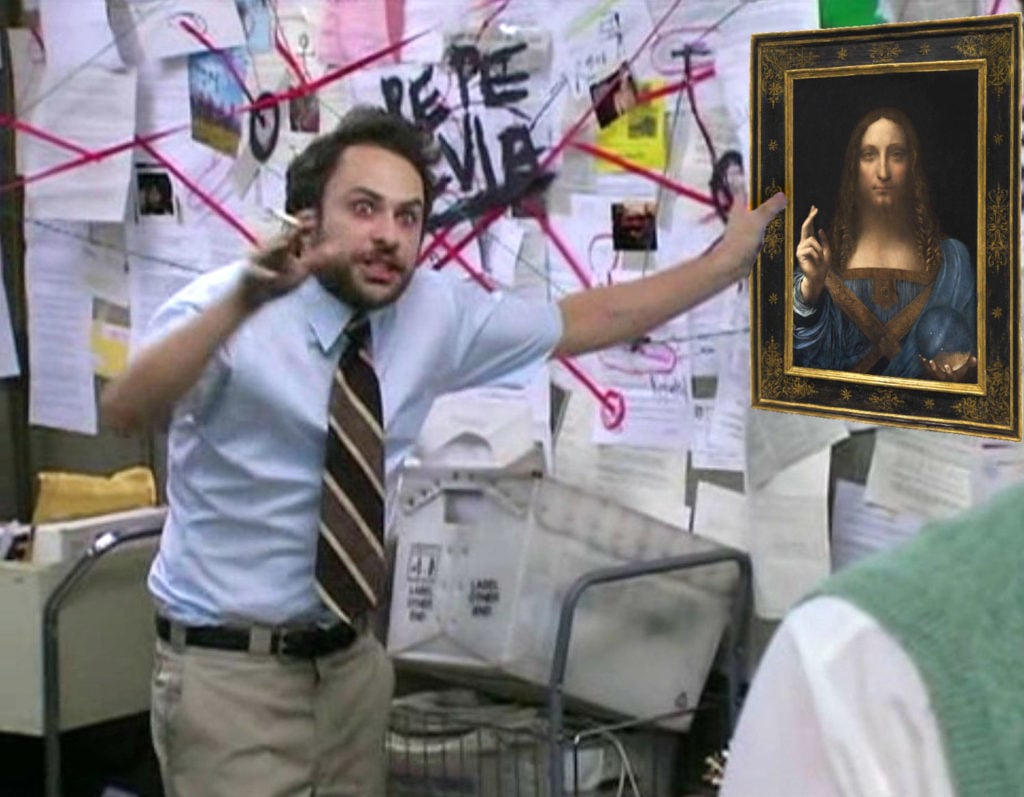
Trump, Russia, Saudi Arabia, Christie's, a new shadowy world order... it all adds up!

Ben Davis

Fake news alert.
Here we are, kicking off 2019 and I am getting asked about this outlandish conspiracy featuring Donald Trump, Robert Mueller, Russian oligarch Dmitry Rybolovlev, an Israeli social media disinformation firm, the record-breaking sale of Leonardo da Vinci’s Salvator Mundi, and… ugh, my brain hurts already.
The much-shared post causing all the commotion hails from a website I’ve never heard of called Narativ, from a writer I’ve never heard of called Zev Shalev. But people are sharing it (Wonkette just picked it up, giving it way too much credence). So go read it if you must.
It manages to cite as major authorities both Jonathan Jones, the Guardian art critic known for embarrassing hot takes, and Seth Abramson, the dean of anti-Trump conspiracy theories.
When you strip it down, essentially it argues that the Crown Prince Mohammed bin Salman of Saudi Arabia and Prince Mohammed bin Zayed of Abu Dhabi hatched a plot to wildly overpay supposed Trump ally Dmitry Rybolovlev for Salvator Mundi at auction, as a way to launder money to pay an Israeli social media operation, Psy-Group, to manipulate the US public.
Does this make sense?
No. Let’s talk about why.
Shalev’s post begins with a long and pointless intro about how the debut of Salvator Mundi at the Louvre Abu Dhabi has been postponed, provocatively stating that bin Salman “appears to have ‘lost’ the world’s most expensive painting.”
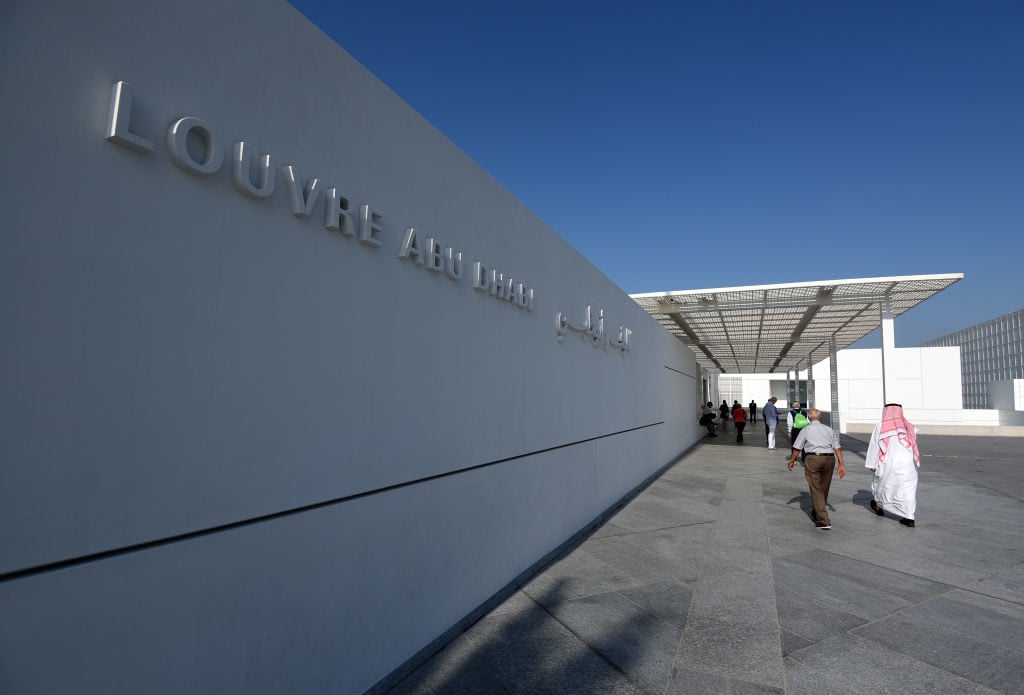
A general view of the Louvre Abu Dhabi museum on January 9, 2018 in Abu Dhabi, United Arab Emirates. Photo by Tom Dulat/Getty Images.
It’s true that the Abu Dhabi Department of Culture and Tourism announced in September that Salvator Mundi’s planned unveiling at the museum would be “delayed indefinitely,” without providing an explanation as to why. And it’s also true that three art-world figures went to the press with concerns about the painting’s care in the wake of that announcement: Oxford scholar Martin Kemp, who authenticated Salvator Mundi as a true Leonardo; conservator Dianne Dwyer Modestini, who executed its extensive repair; and dealer Robert Simon, who acquired the work for a mere $10,000 in 2005, before its reattribution.
But there is a gaping chasm between this trio’s concerns and a credible argument that the painting has been “misplaced,” let alone by bin Salman. As would-be proof, Shalev offers up Kemp, who proclaimed to the Times on November 23, “Nobody outside the immediate Arab hierarchy knows where [Salvator Mundi] is.”
Which means… nobody knows where it is—except for the people who actually own it.
For its part, the UAE paper the National guessed that they might just be waiting for the one-year anniversary of the new museum to unveil it.
The juicy bits of the Times piece are how erratic the “new owners” of the painting seem. They demanded to take possession from Christie’s back in May on short notice, even at the cost of getting an inferior, less-protective acrylic cover put on it rather than the slow-to-manufacture museum-quality glass cover—but then evidently dallied on getting the painting to its Zürich-based conservator, who had been contracted for insurance purposes. It’s in that context that Robert Simon frets, “I am trusting and believing that, wherever it is, there are people who understand that it is a 500-year-old, very fragile work of art and that they are keeping it in museum conditions.”
The truth is that everything about how we found out Salvator Mundi was going to the Emirates was weirdly scattershot in the first place, announced on social media in a way that apparently blindsided the Louvre Abu Dhabi’s official PR team. It all reads less as a sinister conspiracy than as amateur hour, or, maybe more to the point, herky-jerky maneuvers to suit the shifting whims of an autocrat.

A visitor takes a photo of Leonardo da Vinci’s Salvator Mundi painting at the Christie’s in New York during its final day of viewing in New York, United States on November 15, 2017. Photo by Mohammed Elshamy/Anadolu Agency/Getty Images.
In fairness to Shalev, people in the art world are certainly very curious about what’s happening with Salvator Mundi, given that it is the world’s most expensive painting. Even so, I’m not even really sure what this has to do with anything, or what is being implied, besides a vague sense of dark doings.
“Questions are being raised,” Shalev writes. Which questions? By whom? To what end?
Given the many insinuations out there about Dmitry Rybolovlev’s connection to Trump and Russia, and that Rybolovlev was the owner of the purported Leonardo, conspiratorial memes about the Salvator Mundi’s connection to #Russiagate began shortly after the historic sale. These got rolled together with suspicions about the auction-house hype around the painting, so soon it became an “obviously fake” Leonardo, being sold by a Trump ally, for a mysteriously inflated price.
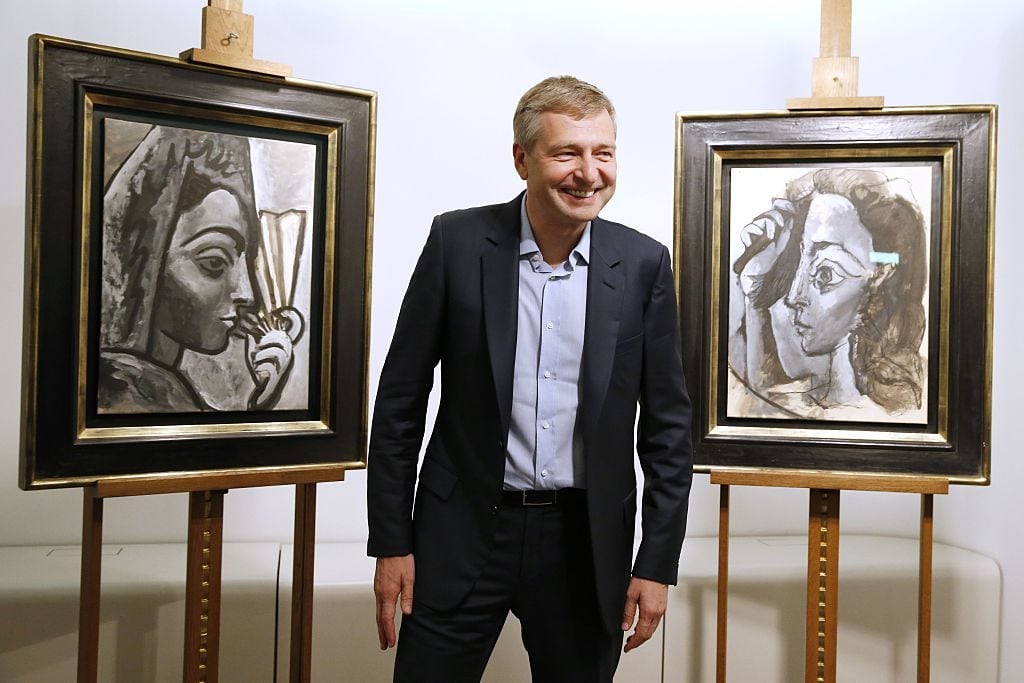
Russian businessperson Dmitry Rybolovlev poses in Paris on September 24, 2015 in front of two allegedly stolen paintings by Pablo Picasso, Espagnole a l’Eventail (left) and Femme se Coiffant, which he purchased from Swiss art dealer Yves Bouvier. Image courtesy AFP Photo/Patrick Kovarik.
At the time, all this seemed trivial, if also an unfortunately illustrative parallel to long-running right-wing, anti-science, everything-is-connected paranoia, the hallmark of which is the undermining of belief in experts and facts in favor of what feels right. This is exactly what started to happen with Salvator Mundi.
There is considerable dispute over the authenticity of the painting. Even if it is the real thing, it was badly damaged and substantially restored, so the extent to which you can call it “from the hand of Leonardo” is debatable.
I actually sort of like it, but what do I know? I have taken the time to read the evidence, but I am not an expert as to the authenticity. Let the professional authenticators, scholars, and conservators argue it out. There are experts like Kemp who do think it is by Leonardo, whom I have no reason to believe are bought off by Christie’s. But then again, who trusts experts anymore, especially when they’re backed by boring things like research and training?
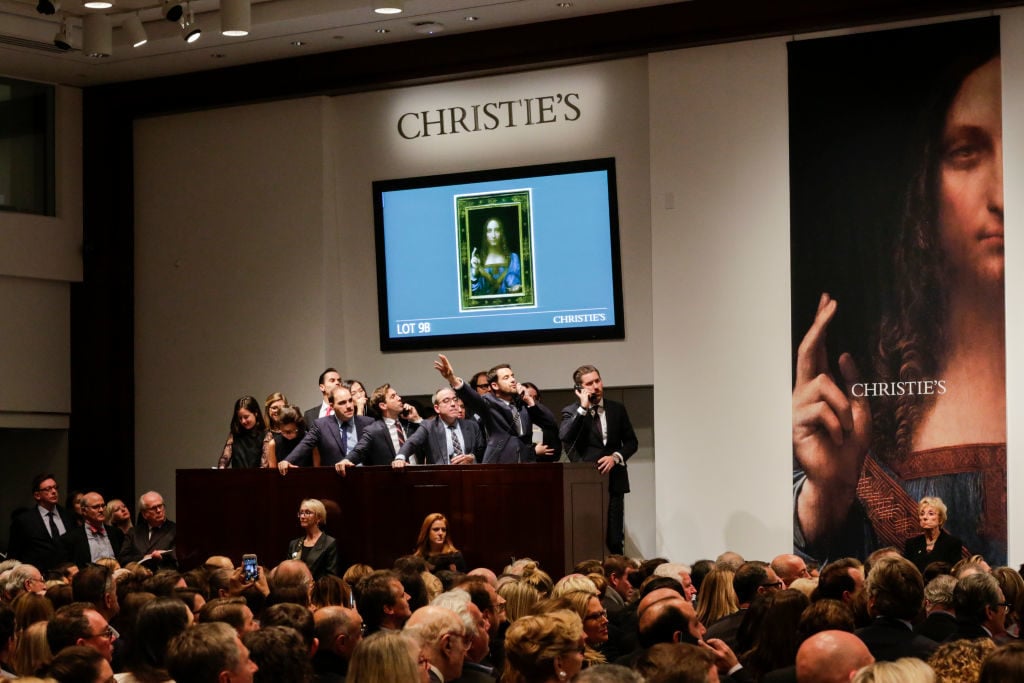
Agents speak on their phones with their clients while bidding on at the auction of Leonardo da Vinci’s Salvator Mundi during the Post-War and Contemporary Art evening sale at Christie’s on November 15, 2017 in New York City. Photo by Eduardo Munoz Alvarez/Getty Images
As an amount to pay for anything, $450 million is an absolutely enraging sum—and the art market is indeed often crooked, easily manipulable, and a playground for plutocrats’ questionable decisions. I get the emotional appeal of saying that whoever paid a half billion dollars for this dodgy, damaged painting is either a clueless rube who was suckered or else has some other sinister agenda.
Did the winning bidder at Christie’s overpay for the painting? Maybe. Maybe they even overpaid by a lot. But much of Shalev’s reasoning depends on a different idea altogether: that the mystery bidder, supposedly bin Salman, overpaid by so much that something fishy is going on.
Let me propose a counter-hypothesis. The Saudi Crown Prince has a personal net worth of $17 billion. The average US household has a net worth of about $76,000. So for bin Salman, dropping $450 million at auction is roughly the equivalent, relative to his personal fortune, of spending $2,000 in everyday-American terms.
Or, if you think of it in terms of Saudi royal family wealth as a whole, MBS’s war chest holds something like $1.4 trillion. In those terms, spending $450 million is roughly the equivalent of spending… 24 bucks.
I mean, it’s a record-setting sum (and unwieldy enough that it had be paid in installments). But it’s not a lot of money to him. If Mohammed bin Salman wants to buy an expensive but dubious Leonardo on a whim, just because there’s enough hype about it and he’d like to offer it to his buddy in Abu Dhabi who happens to be opening a new version of the Louvre on a much-ballyhooed but widely criticized “Happiness Island”—why not?
That explanation already contains plenty that is unsavory, while also being closer to plausible.
But… but… maybe it’s all a part of a secret global plot to elect Trump?
The Narativ theory leans heavily on a New York Times story about a pre-election Trump Tower meeting between a representative of the Saudi and Emirati princes; Erik Prince, the former head of the mercenary firm Blackwater; a representative of an Israeli disinformation firm; and Donald Trump, Jr. There, the royals’ representative supposedly relayed to Don Jr. that they, in the Times‘s paraphrase, “were eager to help your father win election as president.”
The implication is that somehow the princes would go on—a year after the election was over—to secretly pay the Israeli firm, using the Leonardo purchase as a vehicle to move money to the Russian owner of the painting. Which seems like a notably big, weird, very public, extremely costly way to go about this particular Black Op, no?
(At this point in his essay, Shalev also bizarrely switches into omniscient third-person narration, suddenly transforming into a low-budget Le Carré: “As the three men made small talk, President Obama was on TV pleading with the Republican Party to reject Trump as their candidate, and calling him ‘unfit to serve.’ Prince smiled and checked his watch. He knew Obama’s criticism would only strengthen Trump’s chances.” Why this shift? I don’t know. Questions are being raised!)
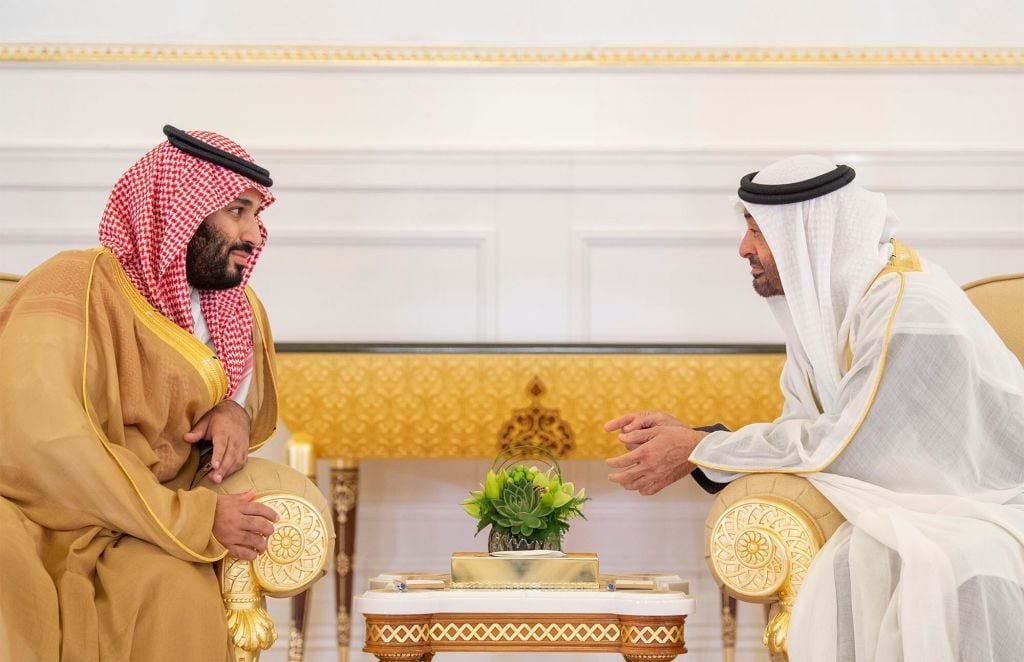
Mohammad bin Salman al-Saud (left) meets Crown Prince of Abu Dhabi Mohammed bin Zayed Al Nahya on November 22, 2018. Photo by Bandar Algaloud/Saudi Kingdom Council/Handout/Anadolu Agency/Getty Images.
The would-be smoking gun is that the two princes who supposedly wanted Trump to win were, reportedly, also the final two anonymous phone bidders for Salvator Mundi, colluding to drive up the price as part of the scheme to benefit Rybolovlev.
But nota bene, there’s yet another conflicting report in Reuters, which has the Abu Dhabi Department of Culture and Tourism buying the painting directly, through a Saudi proxy—so it’s safe to say from the jumbled public record that nothing is certain enough to draw world-historical conclusions. For that matter, the idea that Mohammed bin Zayed, crown prince of the UAE, was the underbidder for the record-setting painting comes from a single report in the tabloid the Daily Mail—which is something like the opposite of the “newspaper of record” (it’s the most inaccurate paper in the UK, by a country mile). The tidbit has not, to my knowledge, been otherwise confirmed.
The Mail cites a lone anonymous “Emirati palace source.” And while Shalev makes a leap from that not particularly rock-solid source to the idea that the two princes were therefore working together to bid up the work for Trump-collusion reasons, the very same “source” specifically indicated that the two princes did not know about each others’ bidding.
The whole point of this tenuously reported story—and the reason that it too went viral—was this right-hand-unaware-of-the-left-hand’s-motion absurdity.
Why were the princes willing to pay so much, according to the Mail? The answer didn’t have anything to do with Trump, but with intra-Middle East rivalry: “Each of them thought they were bidding against the Qataris, and didn’t want them to get it.” To lap up the Mail tale of dueling royals and then ignore everything else about the report is, well… what’s that thing that comes out of the back of a bull?
“At first, laundering hundreds of millions of dollars in full view of a global audience, may not seem like the smartest move,” Shalev sagely concludes (the weird comma after “audience” is his), “but the facts support this may have been what the two crown princes and Dmitry Rybolovlev tried to do.”
Calling what he has assembled “facts” seems a bit of a stretch. But even if we assume every “fact” here to be true, the end result asks us to believe in an international conspiracy ring crafty enough to concoct this elaborate Rube Goldberg plot—but too dumb to figure out a less belabored way to accomplish its sinister ends.
Call me a Russian plant if you will, but I’m gonna propose that maybe its just a case of stupidly wealthy people spending a stupid amount of money on something.
All of this is getting too much into the weeds of a tangled theory. The point isn’t the specifics, really, it’s just that this should transparently be an example of exactly the sort of seductive silliness that propels online conspiracy thinking. And it is all doubly funny because it revolves around Trump’s attempt to somehow employ the services of an Israeli social media disinformation firm in an effort to… distract and confuse his enemies. The snake eats its own tail in the end, doesn’t it?
Let’s make a New Year’s resolution to never talk about this again.